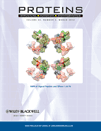On the stoichiometry of Deinococcus radiodurans Dps-1 binding to duplex DNA
Department of Cell and Molecular Biology, University of Chicago, Chicago, IL 60637.
Abstract
DNA protection during starvation (Dps) proteins, dodecameric assemblies of four-helix bundle subunits, contribute to protection against reactive oxygen species. Deinococcus radiodurans, which is characterized by resistance to DNA damaging agents, encodes two Dps homologs, of which Dps-1 binds DNA with high affinity. DNA binding requires N-terminal extensions preceding the four-helix bundle core. Composed of six Dps-1 dimers, each capable of DNA binding by N-terminal extensions interacting in consecutive DNA major grooves, dodecameric Dps-1 would be predicted to feature six DNA binding sites. Using electrophoretic mobility shift assays and intrinsic tryptophan fluorescence, we show that dodecameric Dps-1 binds 22-bp DNA with a stoichiometry of 1:6, consistent with the existence of six DNA binding sites. The stoichiometry of Dps-1 binding to 26-bp DNA is 1:4, suggesting that two Dps-1 dodecamers can simultaneously occupy opposite faces of this DNA. Mutagenesis of an arginine (Arg132) on the surface of Dps-1 leads to a reduction in DNA binding. Altogether, our data suggest that duplex DNA lies along the dimer interface, interacting with Arg132 and the N-terminal α-helices, and they extend the hexagonal packing model for Dps–DNA assemblies by specifying the basis for occupancy of available DNA binding sites. Proteins 2011; © 2012 Wiley Periodicals, Inc.




